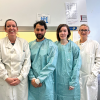Professor Simon Clark discusses how his international team of scientists identified a protein that is strongly linked to the most common cause of blindness in developed countries.

Age-related macular degeneration (AMD) is one of the main causes of impaired sight and blindness in adults, affecting around 600,000 people in the UK alone. There are two distinct types of the disease: the first is “wet” AMD, which is caused by the growth of abnormal blood vessels in the eyes, though the progression of this growth can be slowed when treatment drugs are injected into the eye. The second is “dry” AMD, which occurs when a fatty substance called drusen slowly builds up at the back of the eye. This type accounts for the vast majority of AMD cases and, unlike its less common sibling, is completely untreatable. However, that might be about to change.
New treatment?
In a major international study published in Nature Communications in February, a team drawn from the universities in Manchester, Cardiff, London and Nijmegen, along with Manchester Foundation NHS Trust, has detected a link between the onset of dry AMD and raised blood levels of a protein called FHR4 (factor H-related protein 4). If researchers can confirm their results, it could prompt a treatment for the disease that wouldn’t even involve touching the eye.
One of the supervising authors of the work is Professor Simon Clark from the Institute of Ophthalmic Research at the University of Tübingen in Germany. He says the drive to find a suitable therapy for dry AMD has gradually been gathering momentum, laying the foundations for the research.
“At the back of the eye there is an immune process involving something called the complement system, and we know that there is a genetic link between this becoming overactive and an increased risk of AMD, but nobody was sure of the biochemistry behind that. Even less was known about these mystical factor H-related proteins, which are on chromosome one. Most of the genetic risk for AMD is in the factor H gene, which is also on chromosome one. But it turns out that the mutation in this factor H gene doesn’t affect the factor H protein, but instead affects a protein a couple of genes downstream on the chromosome.”
Stumbled across it
This initial work was groundbreaking, he says, because it blew open the door for other possible mechanisms. “Everybody assumed that the mutation would affect the gene it was found in, but no. What our work has shown is that the consequence of this mutation is increased circulating levels of this protein called FHR-4, which in itself is not particularly harmful but for some reason accumulates at the back of the eye, and there it
helps to drive an inflammatory response, which then leads to the formation of drusen and the other associated phenotypes of dry AMD.”
The irony is that the research initially had no real intentions of going down the AMD route. “My laboratory studies the regulation of the complement system in every disease,” says Clark. “It just so happened we were historically interested in FHR-4. We got our hands on some blood samples and noticed that for some bizarre reason there was more FHR-4 in AMD patients than in non-AMD patients. Then we spoke with the people from Nijmegen who had independently tested another batch of patients and came up with the same results. The next step was to get hold of human eye tissue and take a look at that. In this way, the work has been going on for six years. It wasn’t initially targeted; we literally stumbled across it. After that we got in contact with Valentina Cipriani, the lead author of the paper, who is a leading medical geneticist. She’s the one who pulled together all the genetic links associated with the disease.”
As a result of this work, it is now understood how FHR-4 causes the inflammation. “It knocks off another inhibitor called FHL-1. So, FHL-1 is happily doing its job, then along comes FHR-4 and kicks it off and the whole thing activates.” The other FHR proteins are also being scrutinised. “There are five of them and it is entirely possible that the others are somehow involved. If it is just FHR-4, that’s great, but if it’s only half FHR-4 and half, say, another FHR protein, we need to know that.”
What next
In the meantime, Clark expects other teams will start targeting FHR-4 as a way of slowing down the progression of AMD. This approach could also make treating the disease easier in more ways than one. “The problem we had was not just identifying the correct mechanism, but also the delivery of therapeutics to the back of the eye, which is quite specific about what it lets in and what it keeps out. Here, however, we have a candidate target that is systemic. We can target it in the blood. We don’t have to stick needles in people’s eyeballs at all. Even better, it looks like it is made exclusively in the human liver. So lower transcription levels of FHR-4 in the liver could result in less circulating protein, which means less accumulation at the back of the eye and less inflammation.”
Another boon for any potential treatment regimen will be the blood tests that can detect the circulating levels of FHR-4. “We could stratify susceptible patients easily. Not all AMD is caused by elevated levels of FHR-4, so this is a subset of dry AMD that could be identified for a therapeutic approach. If we can devise that treatment, we also have a ready-made target population.” If a company with FDA approval to deliver therapeutics to the liver chose to target FHR-4, all they would have to do is design the delivery mechanism. “That initial lead time could be quick,” says Clark. “Then it would be off to clinical trials.”
Professor Simon Clark
- 2002: BSc in biochemistry with immunology, University of Aberdeen
- 2006: DPhil in biochemistry, University of Oxford
- 2006: Postdoctoral researcher, Faculty of Life Sciences, University of Manchester
- 2013: MRC career development fellowship, Faculty of Medicine and Human Sciences, University of Manchester
- 2015: Co-founded the Manchester Eye Tissue Repository
- 2019: Helmut Ecker Endowed Professorship in AMD at Tübingen University
Image credit | Shutterstock




